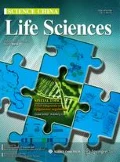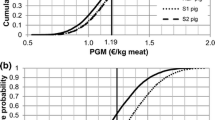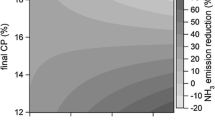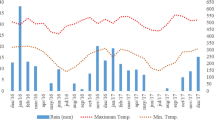Abstract
Animal production systems convert plant protein into animal protein. Depending on animal species, ration and management, between 5% and 45 % of the nitrogen (N) in plant protein is converted to and deposited in animal protein. The other 55%–95% is excreted via urine and feces, and can be used as nutrient source for plant (= often animal feed) production. The estimated global amount of N voided by animals ranges between 80 and 130 Tg N per year, and is as large as or larger than the global annual N fertilizer consumption. Cattle (60%), sheep (12%) and pigs (6%) have the largest share in animal manure N production.
The conversion of plant N into animal N is on average more efficient in poultry and pork production than in dairy production, which is higher than in beef and sheep production. However, differences within a type of animal production system can be as large as differences between types of animal production systems, due to large effects of the genetic potential of animals, animal feed and management. The management of animals and animal feed, together with the genetic potential of the animals, are key factors to a high efficiency of conversion of plant protein into animal protein.
The efficiency of the conversion of N from animal manure, following application to land, into plant protein ranges between 0 and 60%, while the estimated global mean is about 15%. The other 40%–100% is lost to the wider environment via NH3 volatilization, denitrification, leaching and run-off in pastures or during storage and/or following application of the animal manure to land. On a global scale, only 40%–50% of the amount of N voided is collected in barns, stables and paddocks, and only half of this amount is recycled to crop land. The N losses from animal manure collected in barns, stables and paddocks depend on the animal manure management system. Relative large losses occur in confined animal feeding operations, as these often lack the land base to utilize the N from animal manure effectively. Losses will be relatively low when all manure are collected rapidly in water-tight and covered basins, and when they are subsequently applied to the land in proper amounts and at the proper time, and using the proper method (low-emission techniques).
There is opportunity for improving the N conversion in animal production systems by improving the genetic production potential of the herd, the composition of the animal feed, and the management of the animal manure. Coupling of crop and animal production systems, at least at a regional scale, is one way to high N use efficiency in the whole system. Clustering of confined animal production systems with other intensive agricultural production systems on the basis of concepts from industrial ecology with manure processing is another possible way to improve N use efficiency.
Similar content being viewed by others
References
Tamminga, S., Udo, H. J. M., Verdegem, M. J. C. et al., The role of domesticated farm animals in the human food chain, in Quantitative Approaches in Systems Analysis (eds. Stein, A., Penning de Vries F., Schut, J.), Wageningen: AB-DLO/PE, 1999, 21: 67–78.
FAO, FAOSTAT, http://apps.fao.org, 2003.
Smil, V., Eating meat: Evolution, patterns, and consequences, Population and Development Review, 2002, 28: 599–639.
Bruinsma, J. E., World Agriculture: Towards 2015/2030. An FAO perspective, London: Earthscan Publications Ltd., 2003.
Bouwman, A. F., Lee, D. S., Asman, W. A. H. et al., A global high-resolution emission inventory for ammonia, Global Biogeochemical Cycles, 1997, 11: 561–587.
FAO and IFA, Global estimates of gaseous emissions of NH3, NO and N2O from agricultural land, Food and Agriculture Organization of the United Nations, Rome: International Fertilizer Industry Association, 2001.
Oenema, O., Bannink, A., Sommer, S. G. et al., Gaseous nitrogen emissions from animal production systems, in Nitrogen in the Environment: Sources, Problems, and Management (eds. Follett, R. F., Hatfield, J. L.), Amsterdam: Elsevier Science B.V, 2001, 255–289.
World Resources Institute, World Resources 1998–1999, Oxford: Oxford University Press, 1998.
Whitehead, D. C., Nutrient Elements in Grassland. Soil-Plant-Animal Relationships, Wallingford: CABI Publishing, 2000, 369.
Tamminga, S., A review on environmental impacts of nutritional strategies in ruminants, Journal of Animal Science, 1996, 74: 3112–3124.
Sims, J. T., Bergström, L., Bowman, B. T. et al., Nutrient management for intensive animal agriculture: Policies and practices for sustainability, Soil Use and Management, 2005, 21: 141–151
Thompson, P. B., Nardone, A., Sustainable livestock production: Methodological and ethical challenges, Livestock Production Sciences, 1999, 61: 111–119.
Tamminga, S., Pollution due to nutrient losses and its control in European animal production, Livestock Production Science, 2003, 84: 101–111.
Pimentel, D., Huang, X. W., Cordova, A. et al., Impact of population growth on food supplies and environment, Population and Environment, 1997, 19: 9–14.
Smil, V., Nitrogen in crop production: An account of global flows, Global Biogeochemical Cycles, 1999, 13: 647–662.
Mosier, A. R., Kroeze, C., Nevison, C. et al., Closing the global N2O budget: Nitrous oxide emissions through the agricultural nitrogen cycle. OECD/IPCC/IEA phase II development of IPCC guidelines for national greenhouse gas inventory methodology, Nutrient Cycling in Agroecosytems, 1998, 52: 225–248.
Fixen, P. E., West, F. B., Nitrogen fertilizers: Meeting contemporary challenges, Ambio, 2002, 31: 169–176.
Haynes, R. J., Williams, P. H., Nutrient cycling and soil fertility in the grazed pasture ecosystem, Advances in Agronomy, 1993, 49: 119–197.
Harper, L. A., Sharpe, R. R., Parkin, T. B., Gaseous nitrogen emissions from anaerobic swine lagoons: Ammonia, nitrous oxide and dinitrogen gas, Journal of Environmental Quality, 2000, 29: 1356–1365.
Jarvis, S. C., Pain, B. F., Gaseous Nitrogen Emissions from Grasslands, Wallingford: CAB International, 1997, 452.
Sommer, S. G., Génermont, S., Cellier, P. et al., Processes of ammonia emission from livestock slurry in the field, European Journal of Agronomy, 2003, 19: 465–486.
Monteny, G. J., Erisman, J. W., Ammonia emission from dairy cow buildings: A review of measurement techniques, influencing factors and possibilities for reduction, Netherlands Journal of Agricultural Science, 1998, 46: 225–227.
Bussink, D. W., Oenema, O., Ammonia volatilization from diary farming systems in temperate areas: A review, Nutrient Cycling in Agroecosystems, 1998, 51: 19–33.
Van Bruchem, J., Schiere, H., van Keulen, H., Dairy farming in the Netherlands in transition towards more efficient nutrient use, Livestock Production Science, 1999, 61: 145–153.
Rotz, C. A., Management to reduce nitrogen losses in animal production, Journal of Animal Sciences, 2004, 82: E119-E137.
Oenema, O., Pietrzak, S., Nutrient management in food production: Achieving agronomic and environmental targets, Ambio, 2001, 31: 159:168.
Zemmelink, G., ’t Mannetje, L., Value for animal production (VAP): A new criterion for tropical forage evaluation, Animal Feed Science and Technology, 2002, 96: 31–42.
Kamalzadeh, A., Prospects of compensatory growth for sheep production systems, PhD Thesis: Wageningen Agricultural University, 1996, 211.
Ifar, S., Relevance of ruminants in upland mixed-farming systems in East Java, Indonesia. PhD Thesis: Wageningen Agricultural University, 1996, 139.
Sommer, S. G., Hutchings, N., Techniques and strategies for the reduction of ammonia emissions from agriculture, Water Air Soil Pollution, 1995, 85: 237–248.
Huijsmans, J. F. M., Hol, J. M. G., Vermeulen, G. D., Effect of application method, manure characteristics, atmosphere and field conditions on ammonia volatilization from manure applied to arable land, Atmospheric Environment, 2003, 37: 3669–3680.
Amon, B., Amon, Th, Boxberger, J., et al., Emissions of NH3, N2O and CH4 from dairy cows housed in a farmyard manure tying stall (housing, manure storage, manure spreading), Nutrient Cycling in Agroecosystems, 2001, 60: 103–113.
Amon, B., Moitzi, G., Schimpl, M. et al., Methane, Nitrous Oxide and Ammonia Emissions from Management of Liquid Manure, Vienna: University of Agricultural Sciences, ILUET, 2002, 238.
Clemens, J., Huschka, A., The effect of biological oxygen demenad of cattle slurry and soil moisture on nitrous oxide emissions, Nutrient Cycling in Agroecosystems, 2001, 59: 193–198.
Velthof, G. L., Kuikman, P. J., Oenema, O., Nitrous oxide emissions from animal manure applied to soil under controlled conditions, Biol. Fertil. Soils, 2003: 221–230.
Sinclair, R., Von Thünen and urban sprawl, Annals of the Association of American Geographers, 1967, 57(1): 72–87.
De Wilt, J. G., van Oosten, H. J., Sterrenberg, L., Agro Production Parks: Perspectives and Dilemma’s (in Dutch). The Hague: Innovatienetwerk Groene Ruimte en Agrocluster, 2000; heep://www.agro.nl/innovatienetwerk/.
Romstad, E., Simonsen, J., Vatn, A., Controlling Mineral Emissions in European Agriculture. Economics, Policies and the Environment, Wallington: CAB International, 1997.
Henkens, P. L. C. M., van Keulen, H., Mineral policy in the Netherlands and nitrate policy within the European Community, Neth. J.Agric. Sci., 2001, 49: 117–134.
Oenema, O., Governmental policies and measures regulating nitrogen and phosphorus from animal manure in European agriculture, Journal Animal Sciences, 2004, 82: E196-E206.
RIVM, MINAS and Environment, Balance and Exploration (in Dutch), Bilthoven: RIVM, 2002.
RIVM, Minerals better adjusted, Fact-finding study of the effectiveness of the Manure Act (in Dutch), Bilthoven: RIVM, 2004.
Author information
Authors and Affiliations
Corresponding author
Rights and permissions
About this article
Cite this article
Oenema, O., Tamminga, S. Nitrogen in global animal production and management options for improving nitrogen use efficiency. Sci. China Ser. C.-Life Sci. 48 (Suppl 2), 871–887 (2005). https://doi.org/10.1007/BF03187126
Received:
Issue Date:
DOI: https://doi.org/10.1007/BF03187126




